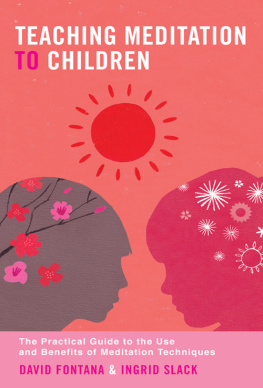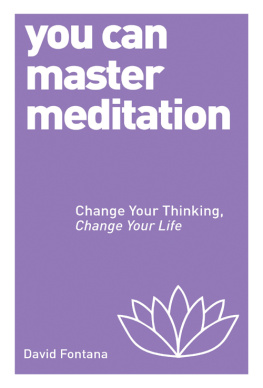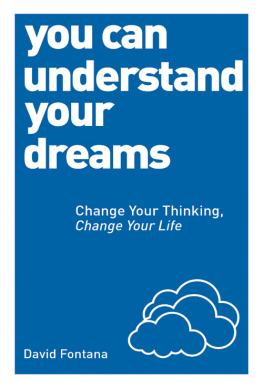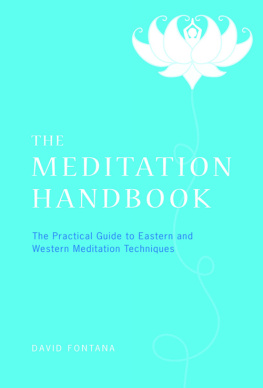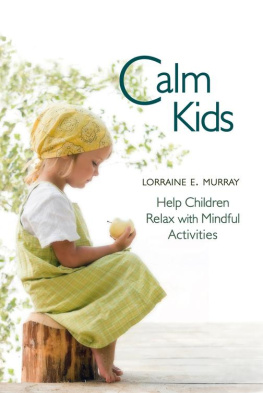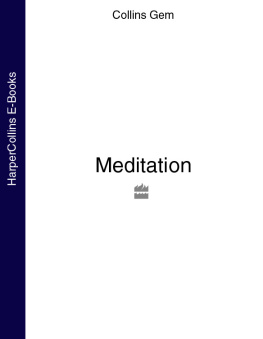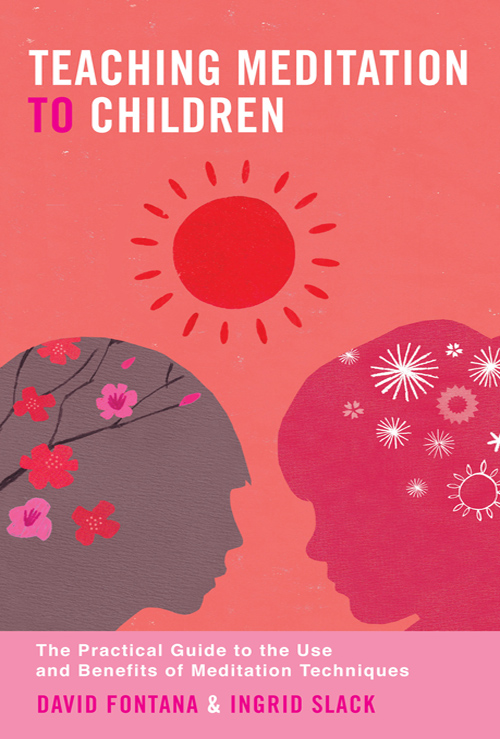Teaching Meditation to Children
A Selection of Books by David Fontana
The Secret Language of Symbols
The Secret Language of Dreams
Meditating with Mandalas
The Elements of Meditation
The Lotus in the City
Know Who You Are, Be What You Want
Growing Together: ParentChild Relationships as a Path to Wholeness and Happiness
Your Growing Child
Learn to Meditate
Learn Zen Meditation
The Meditators Handbook
Meditation Week by Week
Psychology, Religion and Spirituality
Is There an Afterlife?
Other Books by Ingrid Slack
Learning and Conditioning
David Fontana is Distinguished Visiting Fellow to the University of Wales and visiting Professor to the University of Algarve, Portugal. A Fellow of the British Psychological Society, he has studied and taught meditation for over twenty-five years. He has written many highly regarded books on child psychology, dreams, meditation, and psychological counselling.
Ingrid Slack is an experienced teacher of young children, and Associate Fellow of the British Psychological Society, a chartered counselling psychologist, and a workshop leader. Together with David Fontana she is responsible for founding and running the Transpersonal Psychology Section of the British Psychological Society.
Teaching Meditation
to Children
The Practical Guide to the Use
and Benefits of Meditation Techniques
DAVID FONTANA AND INGRID SLACK

This book is dedicated to all children and to the adults who love and care for them, in the hope that it will help them towards peaceful and fulfilling lives.
Acknowledgements
We would like to thank all the adults and children who have worked with us in meditation, particularly those who have let us quote their cases here. A special thank you goes to the staff and pupils in Kents Hill First School in Milton Keynes for their co-operation, flexibility and support.
Foreword to the Second Edition
T he interest aroused since the first appearance of this book and the many requests we have received for its continuing publication have amply confirmed our belief that children value the experience of meditation in their lives. The modern world seeks to dominate children with computer and other electronic games, with mobile phones and frenetic television programmes, with the result that the young are at increasing risk of moving ever further from the experience of being, that is from the experience of connecting fully with themselves, with other people, and with the natural world. Constantly bombarded by noise and by flashing images, constantly distracted by text messages, by mobile phone calls, by emails and by the internet, they have less and less time to pause and experience tranquillity. Where is the space for rest, for thought, for self-exploration, for the creation of harmony between body and mind, and for experiencing real intimacy with loved ones?
The feedback we have received from parents and teachers who have used this book indicates that many children not only find meditation of great benefit in their emotional and intellectual lives, but they also take readily to it. Moreover, we have been greatly encouraged by the eagerness of teachers and parents to use the meditative exercises given in the book with their children. Adults are quick to recognize that these exercises help children from the early years onwards to grow in maturity, self-confidence and self-management; they enhance the relationship children have with their peers and with the adults themselves because meditating together helps bring people of all ages closer to each other. In addition, teachers find that short sessions of meditation help to calm children, either during lessons or at the start and end, and that they can form a valuable feature of personal/social education programmes. Parents find that when used within the home such sessions are a welcome aid in helping young children prepare for sleep after enjoying bedtime stories.
We always suggest that ideally those who teach meditation to children should practise meditation themselves, but we also make clear that to teach the exercises in this book successfully does not require great expertise. Children are simply invited to follow a few straightforward guidelines, and provided that teachers and parents communicate their own belief in the value of meditation, children usually experience little difficulty in absorbing the essentials involved. If, as a parent or a teacher you have never meditated, you might like to try some of the exercises yourself (they will benefit you also) and then try doing them along with your child or children. Meditation is a natural state of mind. Just as we relax the body by keeping it still, so we relax the mind by stilling some of the mental chatter that typically dominates it. And as made clear in the book, meditation is not something that takes us away from the world. It is something that enables us to live richer and more rewarding lives, and to meet more effectively the challenges and opportunities that life brings. Meditation should become part of the education of every child, and it is our hope that this book will continue to help, in however small a way, to ensure that it does.
Apart from small corrections we have made few changes from the First Edition of the book. We remain very grateful to Element Books, who published the First Edition in 1997, and to Thorsons (Harper/Collins) who took over the title from Element and kept it continually in print. Our gratitude now goes to Watkins Publishing (Duncan Baird Publishers) for bringing out this new edition. The fact that the book has now been in constant demand for ten years (rare for books these days) reassures us that the contents and the format are proving helpful to all those interested in offering meditation to children. Working with the young is a sacred trust, and in our careers as psychologists, and formerly as class teachers, we have always found that working with children enhances our own lives in unique and richly rewarding ways. We all receive far more from children than we are ever able to give to them. This is particularly true when it comes to teaching meditation. Working with children in meditation lifts our spirits as well as theirs. It is towards this lifting of the spirits that we dedicate the book.
D AVID F ONTANA AND I NGRID S LACK
Introduction
T his book is for adults, and explains how to introduce children to meditation. The idea of teaching meditation to children is relatively new to the Western world, but in the East meditation has long been accepted as an essential part of early education, laying down skills which are of lifelong benefit.
The book is intended for all adults who wish to teach meditation to children. That includes parents, schoolteachers, youth leaders, social workers, psychologists, church workers, grandparents, uncles and aunts, and anyone who has contact with children in an official capacity and who wishes to help them make the best use of their extraordinary minds. This book is based upon our own experience as psychologists who have worked extensively with children, and who have written about and taught meditation to all age groups.
Children are impressionable human beings, and very much open to direction and influence by adults. Thus any attempt to introduce them to meditation must be done sensitively and wisely (we have more to say about this in Chapter 2), and must empower them not only to meditate, but also to judge the usefulness of meditation for themselves. This ability to judge will allow them to decide whether or not meditation is right for them. Of all activities, meditation is perhaps the one where success most depends upon voluntary participation. In addition, as meditation involves working with ones own mind, children should be given the right to accept or reject it as they think fit.

